We occasionally link to goods offered by vendors to help the reader find relevant products. Some of these may be affiliate based, meaning we earn small commissions (at no additional cost to you) if items are purchased. Here is more about what we do.
Have you heard about Japanese kitchen knives? Made of top-quality steels and tempered to be much harder than their Western counterparts, these kitchen blades are some of the finest cutting tools available.
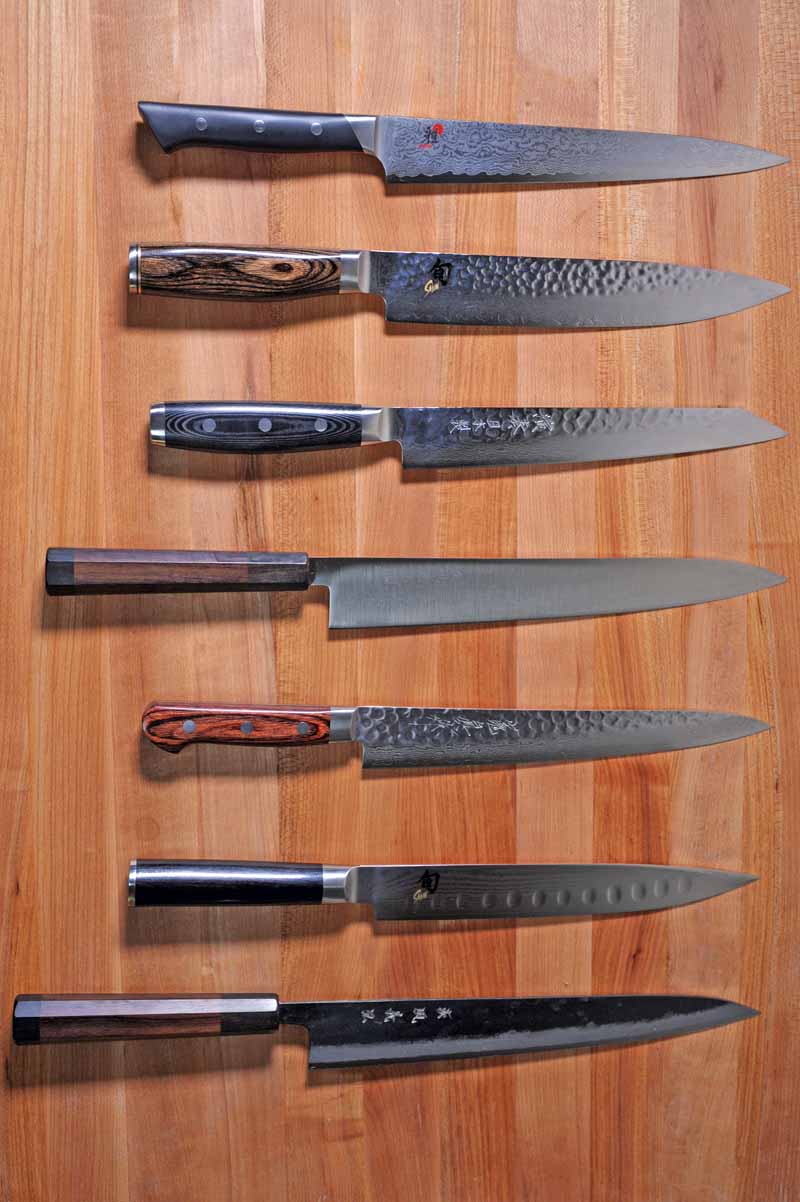
Some are made by individual craftsmen, some are produced in small craft shops, and some in factories. But even the factory-produced models are normally hand-finished by skilled craftspeople.
With handsome aesthetics, top-quality materials, and skillful finishing details, they’re delightful to use and add striking beauty to your collection. And you’ll love using the long, lean sujihiki.
The Japanese version of a slicing or carving knife, the sujihiki started out as a combination of Japanese yanagiba, a single-beveled blade designed for thinly slicing sushi, and Western carving knife. A second bevel was added to the cutting edge, making it a great all-purpose slicer that can even double as a chef’s knife,or a larger petty/kitchen utility if needed.
It features a long, thin blade ranging from 9.5 to 12 inches in length with a narrow heel height to minimize surface area and make thin slices in a single draw. This blade profile also reduces friction and drag, allowing food to easily fall away as it’s sliced.
Some also have decorative finishes, such as Damascus cladding, a hammered tsuchime finish, the rough and unpolished kurouchi look, or fluting along the blade – all of which enhance food-release properties in varying degrees.
Lightweight and with a mid-range flex to the blade, the sujihiki is ideal for trimming proteins or slicing boneless cuts of meat, fish, game, and poultry.
- Bottom Line Up Front: Or Top Two Recommendations
- What to Look For
- Steel Types: Stainless vs. Carbon Steel
- Finishes
- Handle Types: Wa vs. Yo
- Size
- Reviews of Our Favorite Japanese Sujihiki Knives
- Miyabi Fusion Morimito Edition 9-Inch Slicing Knife
- Yoshihiro Ice Hardened 10.5-Inch AUS10 Stainless Steel Wa Sujihiki
- Shun Premier 9.5-Inch Slicing Knife
- Enso HD Hammered Damascus 9-Inch Slicing Knife
- Shun Classic 9-Inch Hollow Edge Carving Knife
- Norisada 9.5-Inch Hammered Damascus Sujihiki
- Yoshihiro 10.5-Inch Mizu Yaki Aogami Super Blue High Carbon Kurouchi Sujihiki
- Sharpening Considerations
- The Final Slice
Bottom Line Up Front: Our Top 2 Recommendations
We spent over $1200 gathering up and testing those models which we felt we could recommend to our readers. We selected our favorite model with a western-style “yo” handle and one with a Japanese style “wa” handle. That being said, there is no bad blade in any of the seven that we have reviewed here. Every single model that we tested is very well crafted. Your choice comes down to your preference regarding handle shape and material, steel alloys, and finishes.
Here are the two that we liked just a tiny bit more than the other options:
Best Sujihiki Slicing Knife with a Western “Yo” Style Handle: Miyabi Fusion Morimito Edition
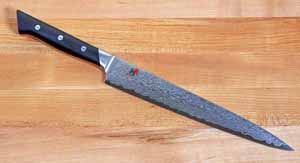
Although we normally prefer longer slicing knives, we can’t overlook the multipurpose applications of this Morimioto Edition from Miyabi. At just 9 inches long, it’s shorter than most of our selections – some of which are a full inch and half longer. The Miyabi’s short blade, paired with a thin, laser-like profile, makes this Miyabi a deft and agile tool that performs admirably at its specified task of slicing protein, but it can serve as an impromptu chef’s knife as well. It also feels delicate enough to serve as a long petty knife, and works well for peeling and chopping veggies and fruits, and performing most general kitchen tasks. Fit and fitness are top notch and the VG10 steel stays sharp for a long, long time.
Check Prices on Amazon or Read Our Review Below
Best Sujihiki Slicing Knife with a Japanese “Wa” Style Handle: Yoshihiro Ice Hardened AUS10 Stainless

Another “laser-like” slicing machine, this Yoshihiro offering is an excellent performer. While there may be others that have fancier finishes, the performance and handling of this blade cannot be be beat. And there is beauty in simplicity as well. The rosewood octagonal handle indexes superbly in the hand, allowing you to know exactly where you are slicing with every stroke. The blade is light and agile, and the whole knife feels like a precision machine. The Yoshihiro AUS10 Stainless model is the Audi of of the Sujihiki world – superb handling without all the flash of a Ferrari.
Check Prices on Amazon or Read Our Review Below
What to Look For
Steel Types: Stainless vs. Carbon Steel
Japanese blades can be divided into two general categories: those that have blades made with a traditional high-carbon steel, and those made with stainless alloys.

While many professional chefs and kitchen knife aficionados (yes, there are collectors) prefer carbon steel for its outstanding sharpness, the “feel” on a water stone, and easier sharpening, newer stainless alloys have narrowed the performance gap between the two categories.
For easier maintenance, stainless alloys won’t rust, have superior corrosion resistance, and are much more impervious to abuse – in fact, six of our seven recommended models are of the stainless variety.
Stainless
Common stainless alloys include VG10 and VG-MAX. Semi-stainless powdered steels such as AUS10 also fall into the stainless category.
VG10 – Referred to as the “gold standard” of the alloys with a high carbon content of at least 1 percent and a hardness of 58-62 HRC. This produces a harder steel than most stainless alloys, and gives very good cutting characteristics. It takes a sharp edge, holds the edge well, and is easy to sharpen. Rust resistance is good, but due to the high carbon content, pitting can be a problem.
VGMAX – A propriety alloy of Shun Cutlery, it builds on the success of VG10 and can be hardened to 61-62 HRC. It has high carbon levels for strength and sharpness, chromium for stain and corrosion resistance, cobalt for strength and hardness, and tungsten creates a fine grain for a sharp, delicate edge.
AUS10 – Another popular alloy, it has good levels of chromium for stain and corrosion resistance, and higher levels of molybdenum and vanadium to increase wear resistance and edge retention. Easy to sharpen and with a long-lasting edge, it has a typical hardness of 58-61 HRC.
Carbon
Super Blue Steel – The only carbon blade in our review is made of Super Blue Steel, a high quality, purified steel with few imperfections. High carbon levels of 1.3 percent plus molybdenum, tungsten, and vanadium give it an extreme hardness at 64-65 HRC, and a long edge life, but it can be a tad brittle as well. Not even close to being stainless, prompt cleaning and regular maintenance are required to keep it at its best.

Finishes
Since many Japanese steels can color slightly and aren’t the prettiest when polished, they’re often covered, or clad, in different stainless alloys of soft and hard steels.

They add important aesthetics to the finished product, and clad finishes also provide blade strength, functionality, and durability.
Damascus – Damascus cladding is achieved by forge-welding two different steel grades together followed by acid etching to revel the unique flowing patterns of the underlying layers. It also provides strength and stability for blade integrity, and gives some food-release qualities as well.
Hammered – A tsuchime finish is hand-hammered on the blade flat and adds an old world, rustic charm as well as excellent nonstick properties. Each hand-hammered finish will be unique, and each depression creates a small air pocket that allows food to fall away from the blade without sticking.
Kurouchi – With plenty of character, a kurouchi or blacksmith’s finish adds handcrafted appeal and helps to prevent reactivity on carbon knives. After forging, the blade flat is left unpolished and retains the scaly, black residue of the forge for a distinctive fired look.
Handle Types: Wa vs. Yo
Wa handles are the traditional choice and are most often made of strips or stacks of wood, such as magnolia, shitan, pakkawood, and ebony. They feature a D, octagonal, or round shape, and may have an integrated bolster and end cap of the same or contrasting material. These are typically peened, pinned, or glued to a full or partial tang.

Magnolia is a favorite choice. A soft wood, it’s light in color and can take a variety of stains, and it also provides a textured hand feel that prevents slipping.
Shitan is strong and heavy, in dark hues of red and brown with a black grain. Durable and dense, it’s hard-wearing and long lasting.
Pakkawood is an engineered wood infused with resin to make it dense and hard. It has the feel and look of wood but none of wood’s common problems – it won’t crack, shrink, or warp and has good wear resistance.
Ebony is dense and heavy, usually dark brown to black in color. It takes on a beautiful, smooth finish when polished that makes it highly prized as an ornamental wood. Tough and durable, it’s often used to finish a handle with a bolster or end cap.
Yo handles are considered a Western design. Usually made of wood or molded thermoplastic, yo handles feature contouring for ergonomic comfort, are often buttressed with a stainless steel bolster, and are riveted to a full or partial tang with two or three rivets.
Size
Long and lean, these beautiful blades are generally available in 8, 9.5, 10, and 12-inch versions. Many home cooks will choose the shortest model at 8 inches, but we like to recommend a longer 9.5 or 10-inch blade – these give greater versatility and will slice all but the largest of roasted meats with a single draw.
Considerably lighter than a Western slicing or carving knife, they’re often referred to as “lasers” by the hobbyist due to their light weight, shape, and precision cutting performance.
The extra length also makes them suitable for prepping sushi, or for use in the barbecue pit to slice through large cuts of meat like brisket.
Join us now for a detailed look at the components involved and reviews of our top rated picks:
In-Depth Reviews of Our Favorite Japanese Sujihiki Knives
1. Miyabi Fusion Morimito Edition 9-Inch Slicing Knife
A member of the Zwilling Group, the Miyabi brand is Japanese designed and crafted at the Zwilling factory in Japan. In our tests, we found that models from the Fusion Morimito line, like this lovely 9-inch slicer, merge the best of Western and Japanese techniques into a knife of deft efficiency and appealing aesthetics.
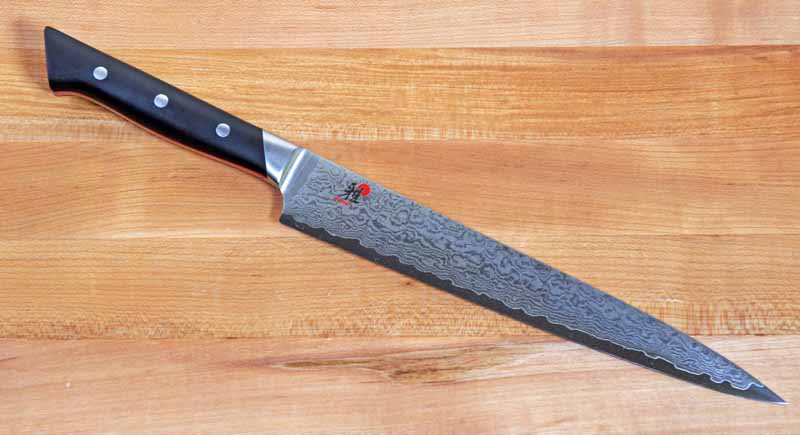
The thin blade is constructed of VG10, a super-steel alloy revered for its ability to hold a keen cutting edge and also withstand rust and stains. Tempered and ice-hardened, the blade is hand-honed in a 3-step process to create a traditional katana cutting angle of 9.5-12 degrees that gives exquisite sharpness.
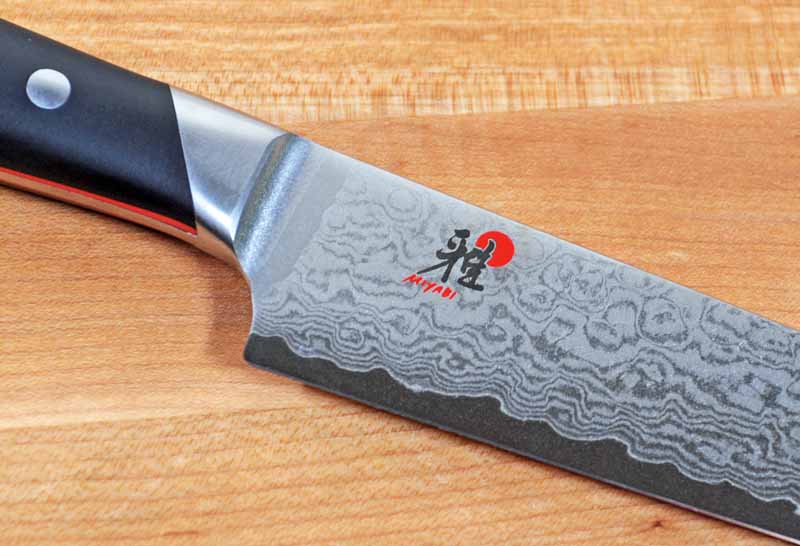
Sixty-four layers of flowing Damascus cladding envelop the core, adding complex aesthetics, toughness, and resiliency that also helps to release food cleanly from the blade.
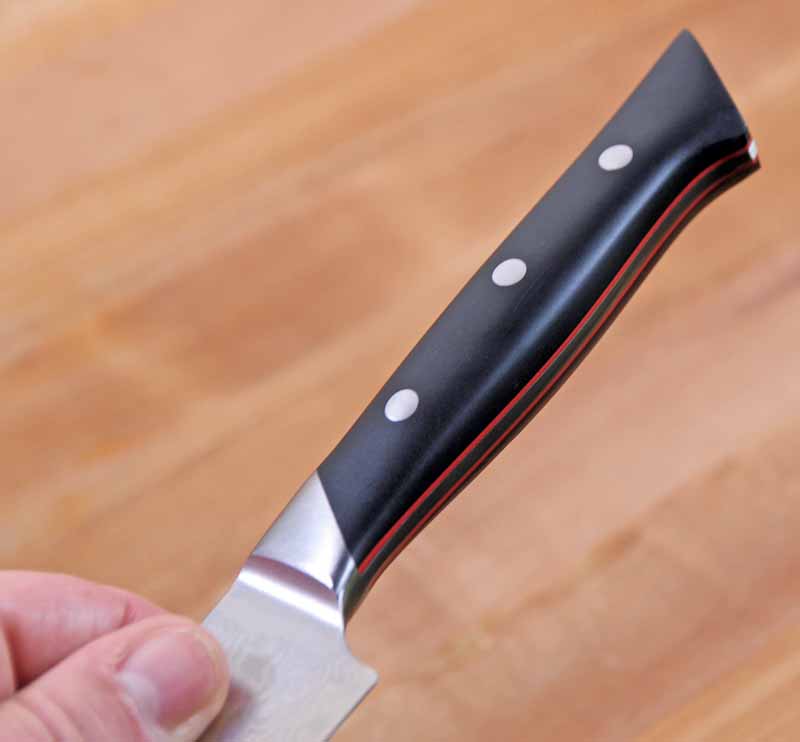
The bolstered handle is made of durable, long-lasting POM (polyoxymethylene) and is designed for ergonomic comfort. The thicker butt end prevents slippage, and three stainless steel rivets attach it securely to the full tang for stability and balance. Red liners under the black scales give the Fusion Morimito a little extra touch of beauty, something normally only found on bespoke custom-made blades.
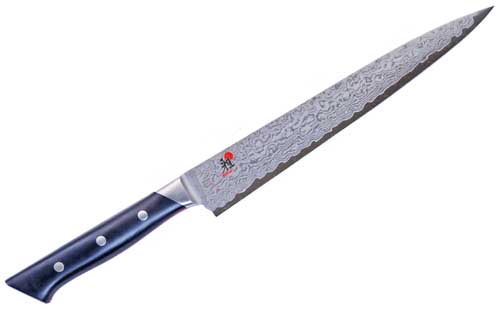
Miyabi Fusion 9-Inch Slicing Knife, available via Amazon or direct from Zwilling
The Miyabi Fusion has the following dimensions:
- 15 inches in overall length
- 9-inch blade length
- 1.5-inch blade height at the heel
- Handle and bolster measure 6 inches
- Weighs 6.4 ounces
Made in Japan, the Fusion comes with a lifetime warranty to be free of defects in materials and workmanship. It is dishwasher safe, but hand washing is recommended.

We love this spectacular knife with its thin, flexible blade and wonderfully sharp edge. Our tests found it to be deft and well balanced, with a responsive hand feel.
Ideal for carving and slicing, it’s also a natural for use as a large utility knife – and it can easily do most of the tasks required of a chef’s knife as well. A beautiful, efficient blend of East and West.
Check prices and read more reviews on Amazon now or find it on Zwilling.com.
2. Yoshihiro Ice Hardened 10.5-Inch AUS10 Stainless Steel Wa Sujihiki
Yoshihiro produces traditional, handcrafted knives of professional quality that are tools of exquisite sharpness, balance, and beauty – like this sleek 10.5-inch sujihiki.
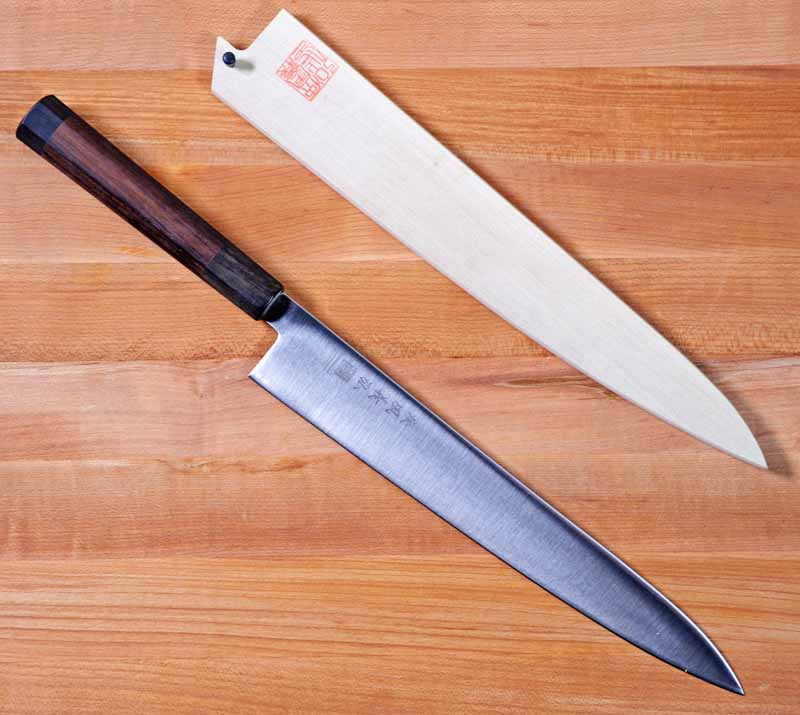
The double-beveled blade is forged from a single billet of AUS10 stainless steel with a carbon content of over 1 percent, for excellent sharpness and edge retention as well as durability.

The steel is ice-hardened for a fine grain that can be ground to a very tight angle for superior sharpness, but also has toughness for long-lasting, consistent performance. Ground in a double bevel of 8-12 degrees, the cutting edge is keen and easily re-sharpened.
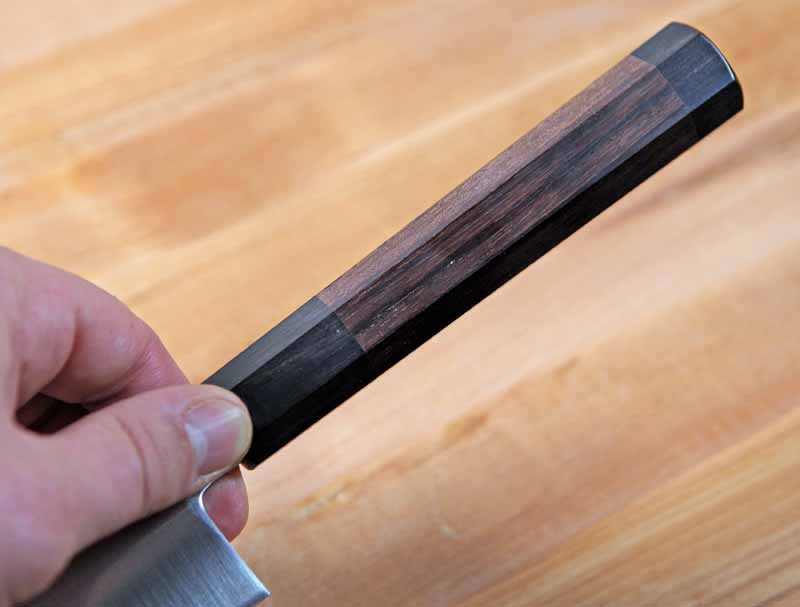
A traditional Japanese-style octagonal rosewood “wa” style handle provides the ultimate in grip and indexing. You’ll always know what angle the blade is facing with this superbly crafted blade. Almost everyone that has tried a wa style handle seems to love it, so if this is going to be your first Japanese kitchen knife, give this one a go and see what you think.
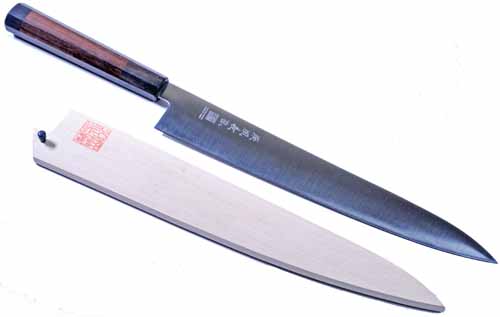
YOSHIHIRO Ice-Hardened High Carbon Stainless Steel Wa Sujihiki
The Yoshihiro has the following dimensions:
- Blade length is 10.5 inches
- Overall length is 15.5 inches
- Measures 1.5 inches at the heel
- Weighs 6.8 ounces
Made in Japan, it comes with the Yoshihiro lifetime warranty to be free of defects in materials and workmanship.
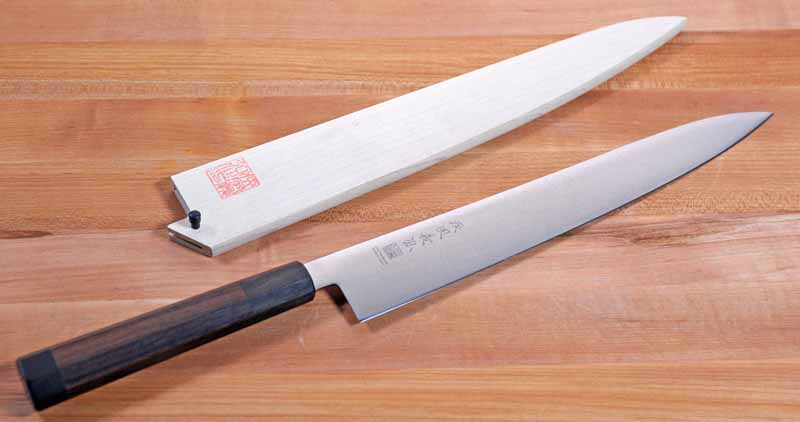
NSF certified for use in commercial kitchens, hand washing with warm, soapy water is recommended.
Remarkably thin and light, the blade boasts outstanding sharpness, edge retention, and the resiliency to perform consistently in demanding conditions.
Perfect for cooks who want a thin, razor-sharp edge for effortless slicing of boneless cuts of meat – but it should not be used on hard objects such as bones, frozen foods, or shells.
Check prices and read customer reviews on Amazon now!
3. Shun Premier 9.5-Inch Slicing Knife
Shun gives us the handcrafted elegance of their 9.5-inch Premier Slicing Knife, featuring a hammered Damascus finish and ultra-hard Japanese steel. Lovely to look at, the blade is deceptively sharp and efficient at slicing a variety of foods, such as fish, ham, poultry, and roasts.
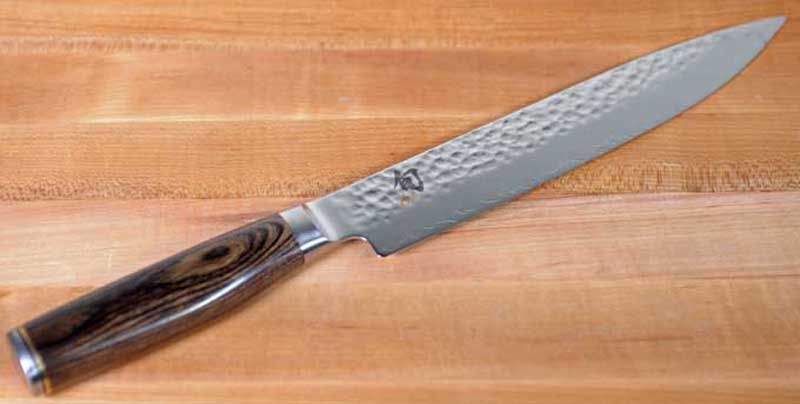
The forged blade is made of Shun’s proprietary, high-carbon “super steel,” an alloy known as VGMAX. The high-carbon steel takes and holds a precise and ultra-sharp cutting edge. The double-bevel edge is ground to 16 degrees per side to create super-thin, even portions, leaving more juices and flavor inside the meat.
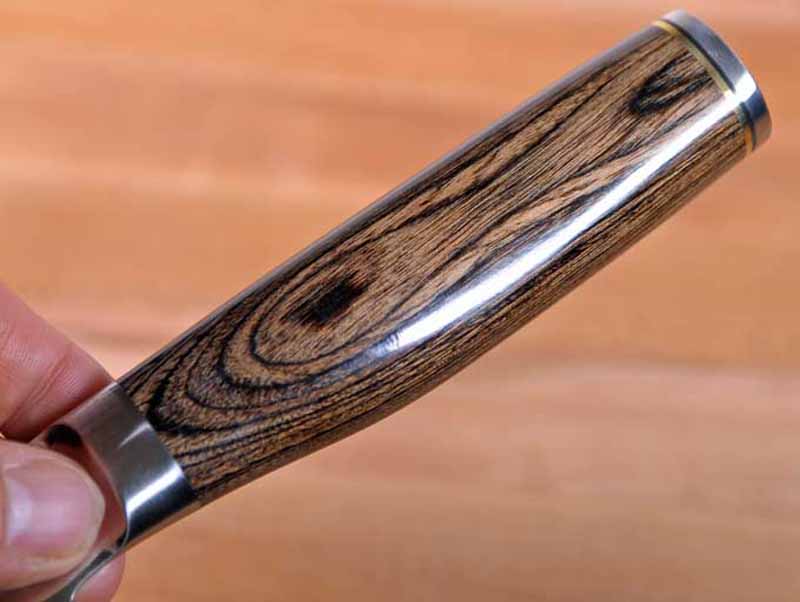
The core is overlaid with 34 layers of Damascus cladding, adding support to the blade as well as stain and corrosion resistance. The cladding is then hand-hammered to a tsuchime finish that reduces friction to cleanly release foods.

A full tang and bolster add balance and agility, and the lightly contoured pakkawood handle has a warm walnut stain. It provides a comfortable, slip-resistant, and sanitary grip and is securely peened to the tang under the stainless steel end cap.
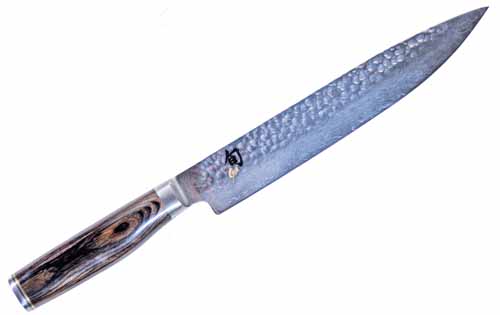
Shun Premier 9.5-Inch Slicing Knife, available via Amazon
The Shun Premier measurements are:
- Blade length is 9.25-9.5 inches (handcrafted, so length can very slightly)
- Overall length is 14.25 inches
- Heel height is 1.5 inches
- Weighs 7.4 ounces
Made in Japan. The Premier comes with Shun’s lifetime warranty to be free of material and manufacturing defects – and Shun also provides free sharpening for life. Dishwasher safe, but hand washing is recommended.
Lightweight, well balanced, and superbly sharp, its smooth cutting action makes clean, even slices with a single draw. And its handcrafted beauty will make a striking addition to your collection.
Best suited for boneless cuts of meat, to protect its edge, this handsome tool should not be used on hard materials or tough-skinned vegetables.
Check prices and read customer reviews now on Amazon.
4. Enso HD Hammered Damascus 9-inch Slicing Knife
This beautiful, handcrafted Japanese slicing knife from Enso Cutlery features Damascus cladding and a hammered finish over a cutting core of VG10 – a specialty alloy favored by many for its ability to take an extremely sharp edge, and excellent edge retention.
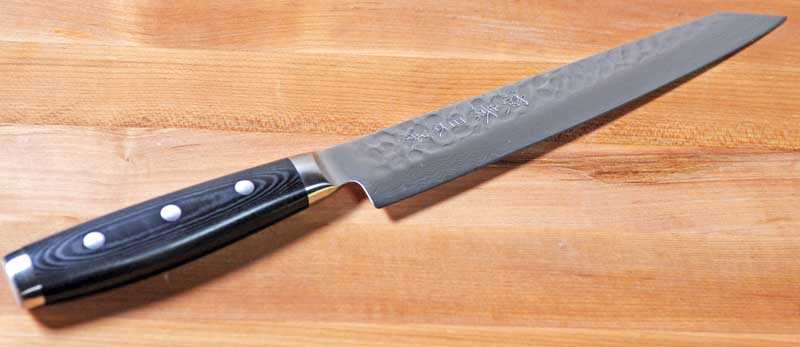
Hardened and tempered, the high-carbon core is overlaid with 36 layers of Damascus cladding for outstanding stain, rust, and corrosion resistance, then ground and polished to revel unique flowing patterns.

The blade has a tight 12-degree double bevel for razor sharpness and a long-lasting cutting edge. And the finish is skillfully hand-hammered to a tsuchime finish for an artistic touch that adds food release qualities as well.
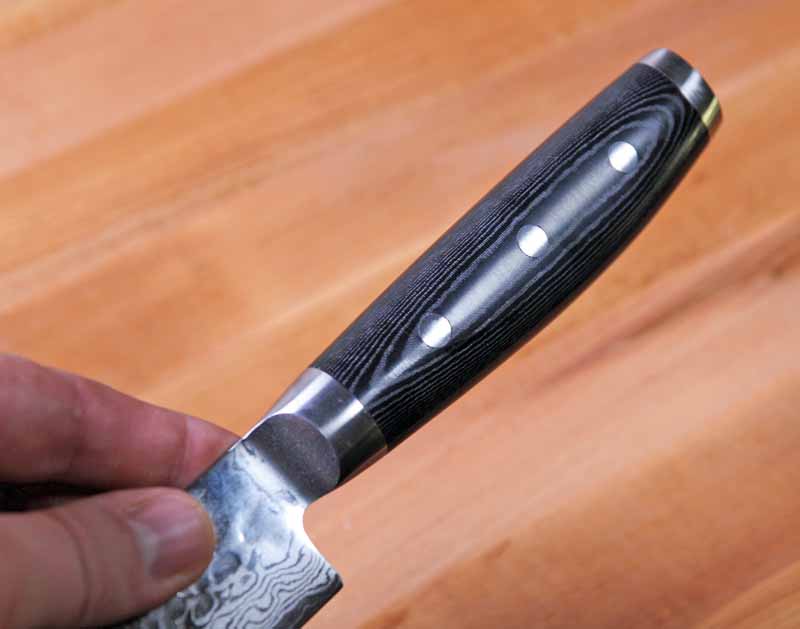
The handle is constructed of FDA approved black canvas micarta, a linen and resin composite that has outstanding durability, stability, and wear qualities. The polished finish has the appearance of wood grain, giving the look of wood without the worry of cracking, shrinkage, or warping.
It has a traditional ovate-shaped wa handle that provides a comfortable, easy grip. It’s also bolstered and attached to the full tang with three stainless steel rivets and finished off with a matching end cap.
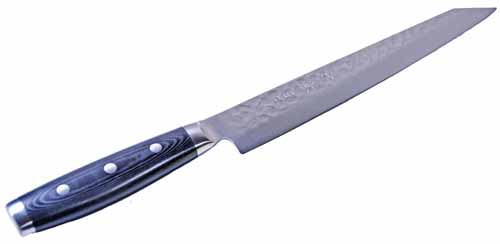
Enso HD Hammered Damascus 9-Inch Slicing Knife
The Enso has the following dimensions:
- Blade length is 9 inches
- Overall length is 14.5 inches
- Blade height is 1.25 inches at the heel
- Weighs 7.6 ounces
Made in Japan. It comes with Enso’s lifetime warranty to be free of defects in materials or workmanship. Hand washing is recommended.
Beautifully balanced, the long, sharp cutting edge makes clean, single-slice draws effortless as food falls cleanly from the blade.
Perfect for carving ham, roasts, turkey, and more, it has a professional fit and finish that any cook will enjoy.
And it comes in an attractive box, suitable for gift-giving or presentation to the knife buff in your life!
Check prices and read customer reviews on Amazon now!
5. Shun Classic Hollow Edge Carving Knife
This beautiful sujihiki from Shun’s Classic line features a long, narrow blade of hard steel with Damascus cladding and a scalloped surface for clean, easy slicing.

The blade is made of Shun’s proprietary VGMAX steel, a hard, durable alloy that takes a scalpel-sharp cutting edge and has superb edge retention. The core is then dressed in 32 layers of Damascus cladding, adding structural integrity and excellent stain resistance, and then ground and bead-blasted to reveal a unique flowing pattern.
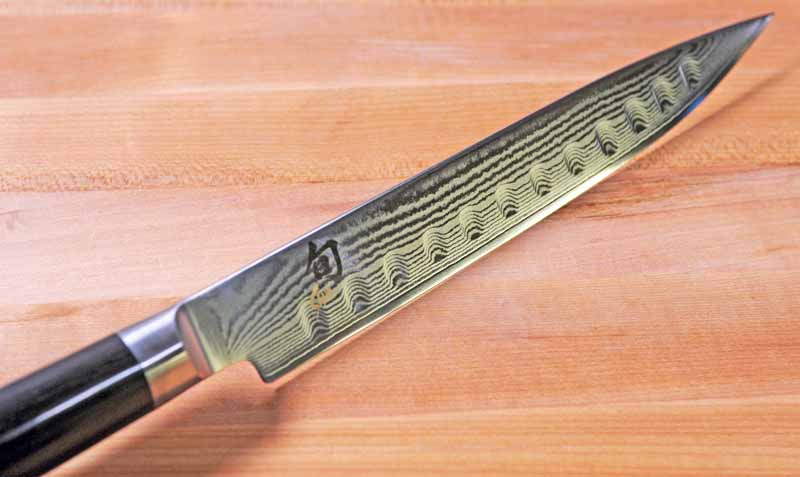
The cutting edge is hand-ground in a double bevel at 16 degrees for smooth cutting performance, and the hollow-ground depressions create air pockets to easily release food from the blade.
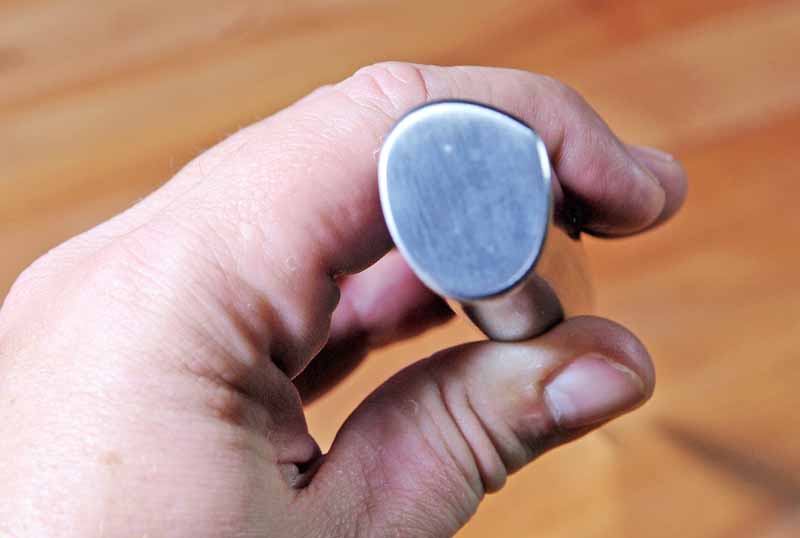
The bolstered handle is made of black pakkawood, a resin-imbued hardwood favored for its tough durability and long-lasting good looks. Styled in a D shape, it’s designed for right-handed, use although the Shun blog reports many lefties employ it with equal ease.
Securely peened to the full tang under the stainless steel end cap, it gives a comfortable grip, stability, and balance to the long blade.
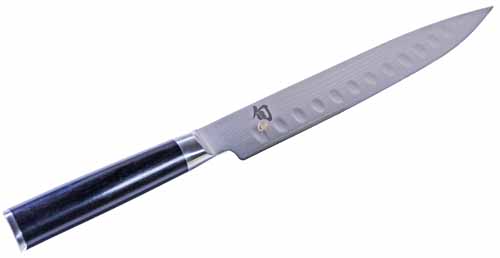
Shun Classic Hollow Edge Carving Knife
The Classic’s dimensions are:
- Blade length is 9 inches
- Overall length is 14 inches
- Heel height is 1.5 inches
- Weight is 6.8 ounces
Made in Japan. It comes with Shun’s lifetime warranty to be free of defects in materials and workmanship, and they also provide lifetime free sharpening.
NSF certified for use in professional kitchens, hand washing and prompt drying with a soft cloth is recommended.
Sharp and durable, the Shun Classic sujihiki is masterful at making precise slices with a single draw, and the scalloped edge lets the blade glide effortless through any boneless meat.
Beautifully crafted of top-notch materials with exacting attention to detail, it’s suitable for the discerning home cook or professional chef. But don’t use it on hard materials such as bone, hard-skinned veggies, shells, and the like.
Check prices and read customer reviews on Amazon now!
6. Norisada 9.5-Inch Hammered Damascus Sujihiki
Norisada also produces traditional knives crafted of top-quality steel that have been adapted to the Western market, like this beautiful 9.5-inch sujihiki.
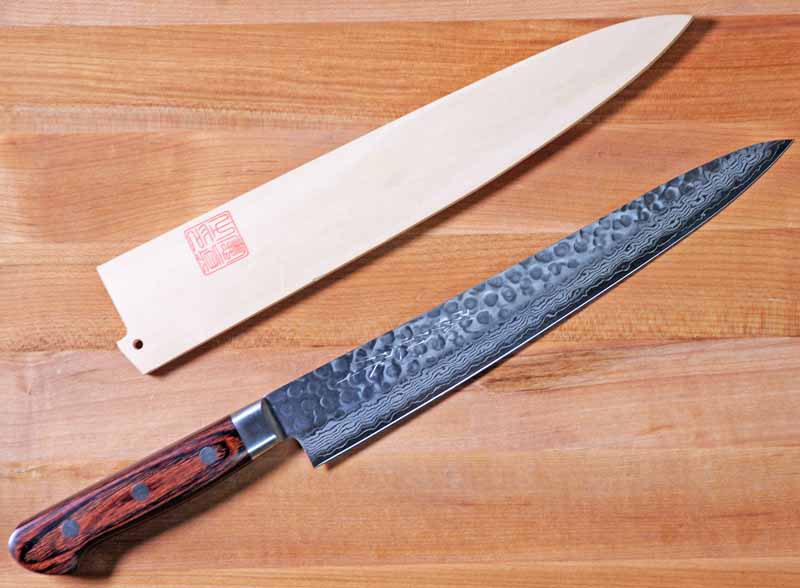
It features Damascus layering and a hammered finish that adds unique artistry to the blade along with nonstick properties, thanks to the small air dimples created by the hammering.
The forged blade is made of VG10 steel, the “gold standard” for cutlery grade stainless steel used for its wealth of desirable characteristics. These include corrosion, stain, and wear resistance, plus extreme hardness and resilient toughness.
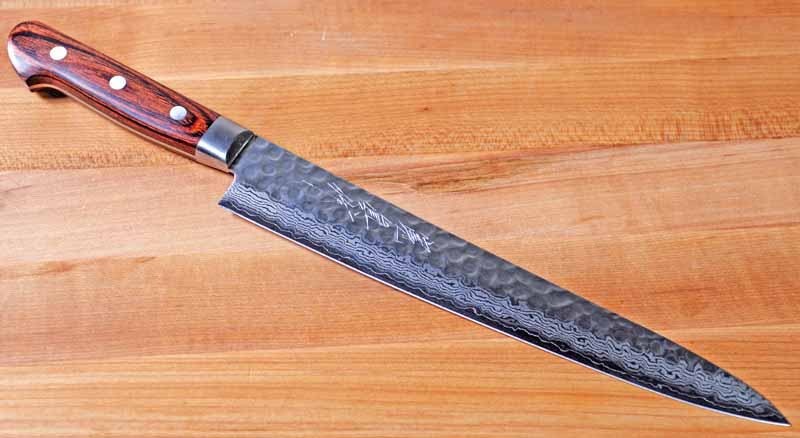
The quenched steel is hardened and tempered, then ground into a double-bevel cutting edge for extreme sharpness and long-lasting edge retention.
Thirty-two layers of Damascus cladding envelop the core, adding excellent corrosion and rust resistance. A hand-hammered finish improves food-release qualities and adds rustic charm.
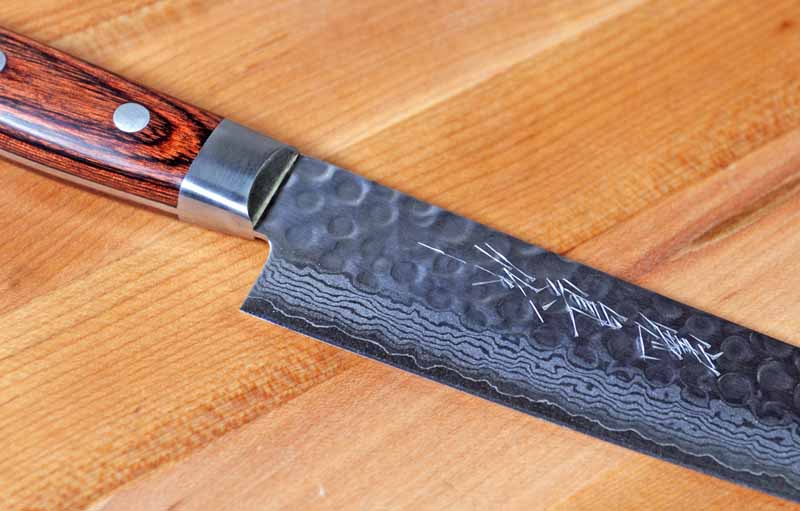
A handle of dense mahogany offers the rich appeal of wood, plus excellent water-resistant qualities. It has a cylindrical wa shape with a slight contour and pronounced heel to ensure a secure, comfortable grip without slipping.
Three stainless steel rivets securely attach it to the full tang for beautiful stability and balance.
It also includes a traditional saya cover made of natural mahogany that provides complete protection for the blade.
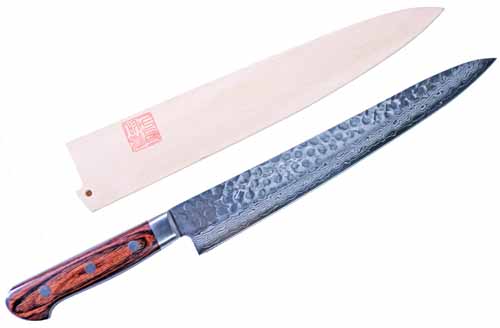
Norisada Hammered Damascus 9.5-Inch Sujihiki with Saya Cover
The Norisada has the following dimensions:
- Blade measures 9.5 inches
- Overall length is 14.75 inches
- Heel height is 1.5 inches
- Weighs 6.6 ounces
Made in Japan. It comes with Norisada’s lifetime warranty to be free of defects in materials and workmanship.
With exacting blade geometry, a sharp cutting edge, and a hammered finish, the Norisada sujihiki glides through proteins with ease.
Handsome and distinctive, it combines first-rate materials with reliable performance that makes it well suited for the home or professional chef – and the included saya cover makes it great for gift-giving!
Check prices and read customer reviews on Amazon now!
7. Yoshihiro 10.5-Inch Mizu Yaki Aogami Super Blue High Carbon Kurouchi Sujihiki
For something more traditional, the 10.5-inch, kurouchi-finished sujihiki from Yoshihiro features an unpolished high-carbon blade and an octagonal wa handle.
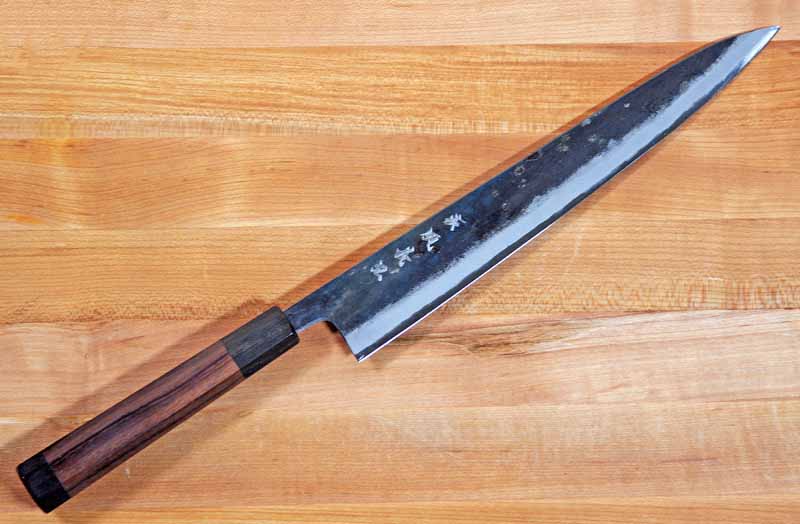
This ultra-hard blue steel is known as Aogami Super Blue, and it can be acutely hardened for an unparalleled scalpel-like cutting edge. A highly pure steel, carbides have been added to give it resiliency and the longest edge life of the blue steels, but it doesn’t have sufficient quantities of chromium to make it stainless.
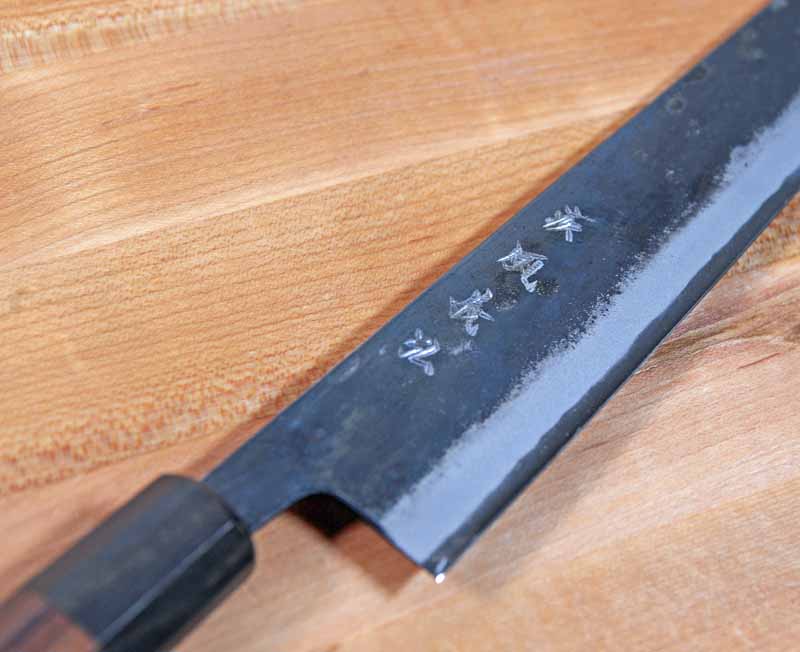
The cutting edge is ground in a double bevel at a keen 11 degrees for superior sharpness, edge retention, and ease of sharpening.
The forged blade is left unpolished for a kurouchi or blacksmith’s finish. The flat of the blade is left with the forging scales in place, giving it a rustic aesthetic and helping somewhat to prevent oxidation.
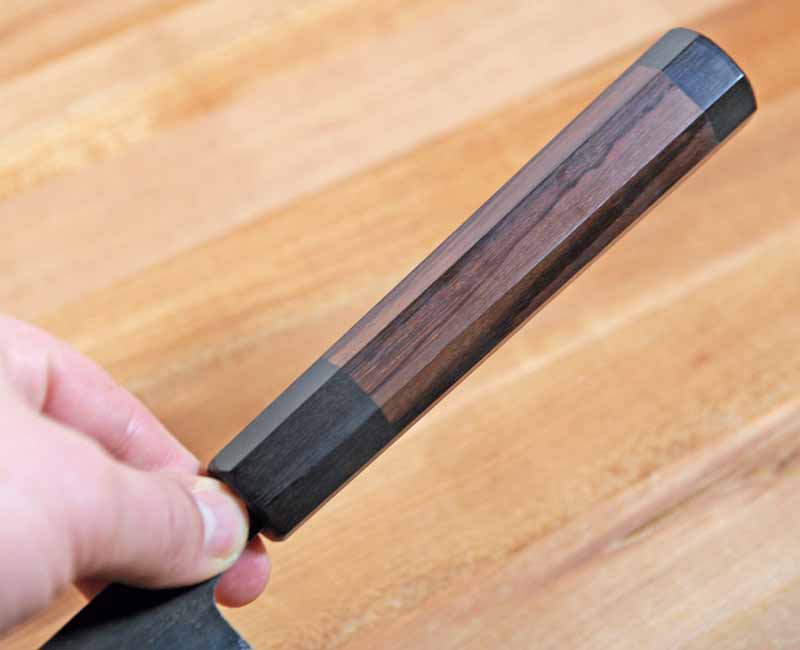
A traditional wa handle is constructed of shitan rosewood, a rich hardwood favored for its dense durability and hard-wearing properties. With an octagonal shape, it’s finished with an end cap and bolster of hard ebony and glued to the full tang for added stability and secure handling.

Yoshihiro 10.5-Inch Mizu Yaki Aogami Super Blue High Carbon Kurouchi Sujihiki
The Yoshihiro has the following dimensions:
- Blade length is 10.5 inches
- Overall length is 15.5 inches
- Heel height is 1.5 inches
- Weighs 7.4 ounces
Made in Japan. It comes with Yoshihiro’s lifetime warranty to be free of defects in materials or workmanship. And it’s also available in a 9.5-inch size.
To prevent oxidation, hand wash promptly with mild, soapy water and dry immediately with a soft, clean cloth. Once it’s clearn and dry, rub a drop of the included oil (or mineral oil) into the entire blade with a soft cloth before storage to prevent rusting.
Perfect for table-side carving, the Yoshihiro’s superior cutting edge elevates slicing large meats to an art form.
With traditional styling, materials, and finish, it’s suited for home and professional cooks who want the sharpest of cutting edges and don’t mind the required maintenance needed to care for the high-carbon steel.
Check prices and read customer reviews on Amazon now!
Sharpening Considerations
To get the most out of these high-end performers, water stones are the method of choice for sharpening hard Japanese steel, using a rough, medium, or fine grit depending on the process required.
Arato stones have a rough grit and surface. These are useful when repairing chips or a broken tip or to improve the edge geometry for a sharper blade.
Nakato stones have a medium grit, and these are used to improve the cutting angle for a sharp blade.
Siageto stones are fine grit, used in the finishing process to refine and perfect the cutting edge, and needed to keep a sharp edge.
The final step is to hone and polish with a leather strop, to remove any burrs from the cutting edge and polish the blade.
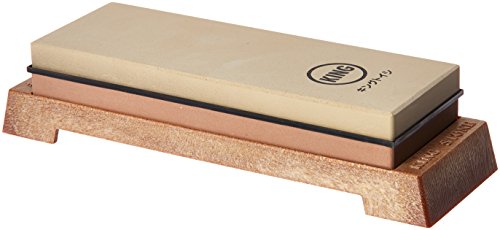
KING KW65 1000/6000 Grit Combination Whetstone with Plastic Base
You can start out with one combo stone, such as this King product, which has a semi-coarse side and a fine/polishing side. This is good enough to satisfy many users, though some enthusiasts make this into a hobby of sorts and like to try different stones and sharpening regimes.
The Final Slice
Superbly sharp with deft handling, these long-bladed knives are the go-to tool for any slicing or carving tasks – and they make a fantastic impression at the holiday table or on any special occasion!
Remember that with their high-carbon alloys, a little care needs to be taken to keep them at their best. Avoid using them on hard materials that can damage their exacting cutting edge, never allow them to sit in water, and always remember to wash and dry promptly after use.
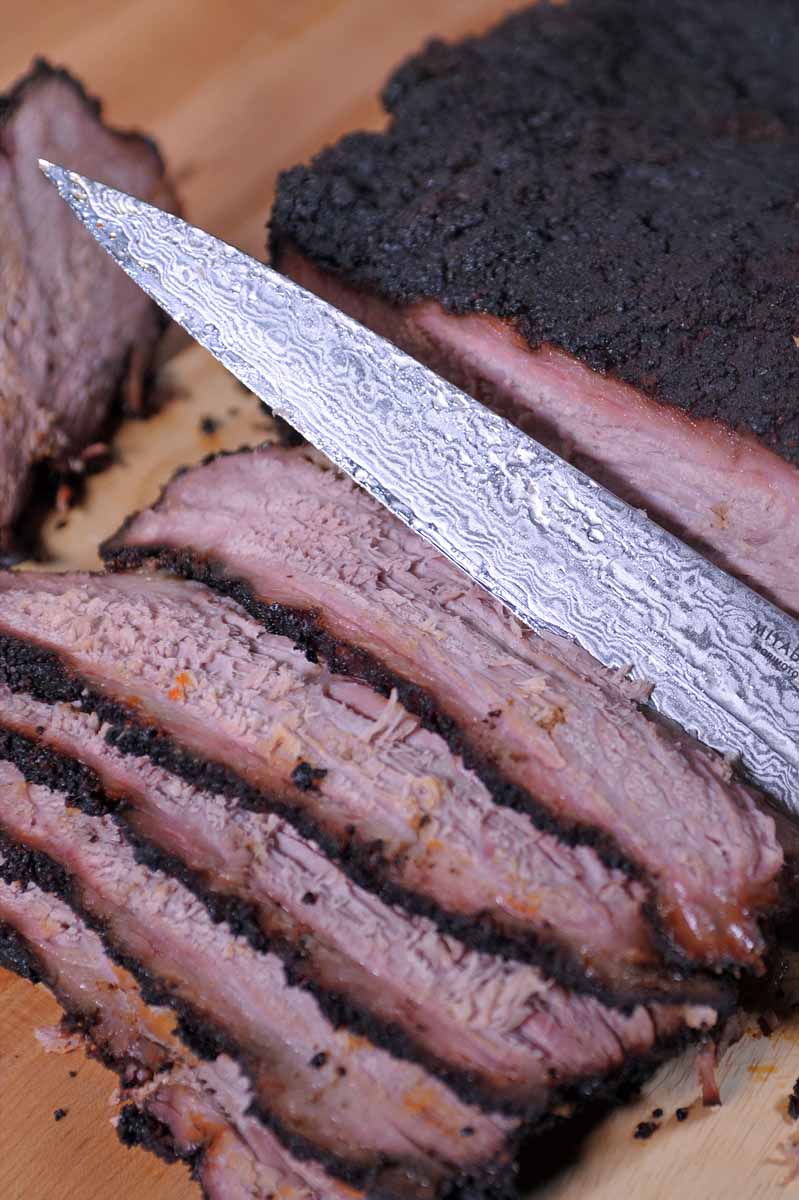
Do these few things for your sujihiki, and you’ll enjoy their stunning beauty and cutting performance for years!
Photos by Mike Quinn, © Ask the Experts, LLC. ALL RIGHTS RESERVED. See our TOS for more details.
About Lorna Kring
Recently retired as a costume specialist in the TV and film industry, Lorna now enjoys blogging on contemporary lifestyle themes. A bit daft about the garden, she’s particularly obsessed with organic tomatoes and herbs, and delights in breaking bread with family and friends.

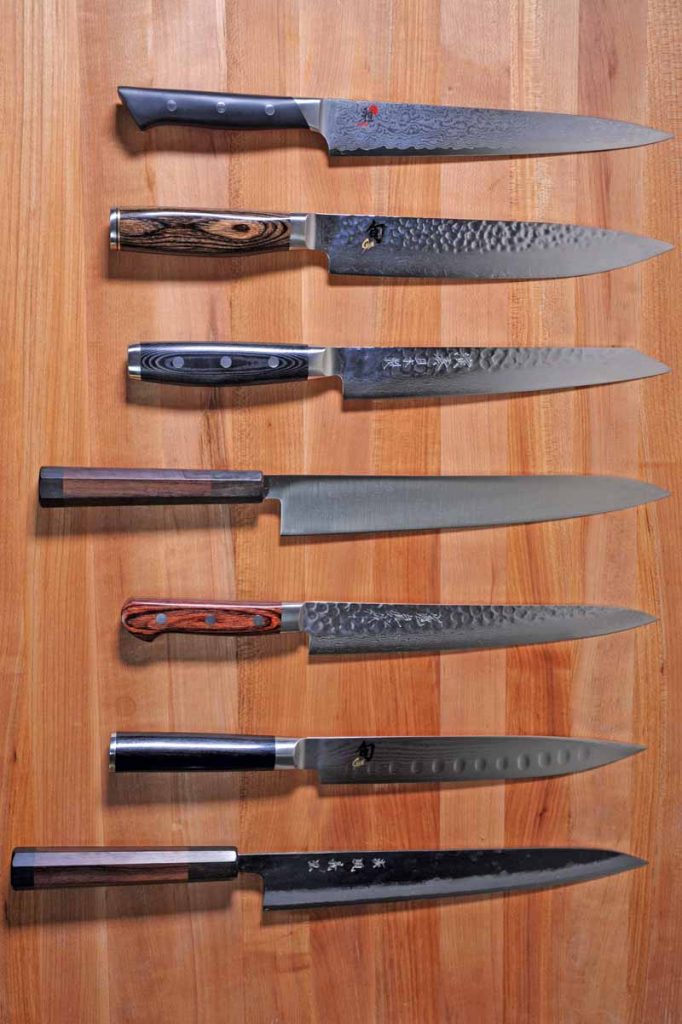

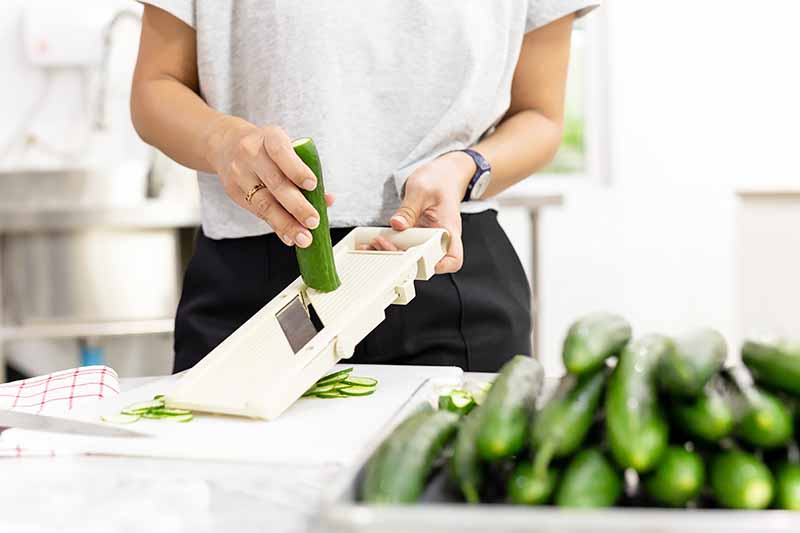
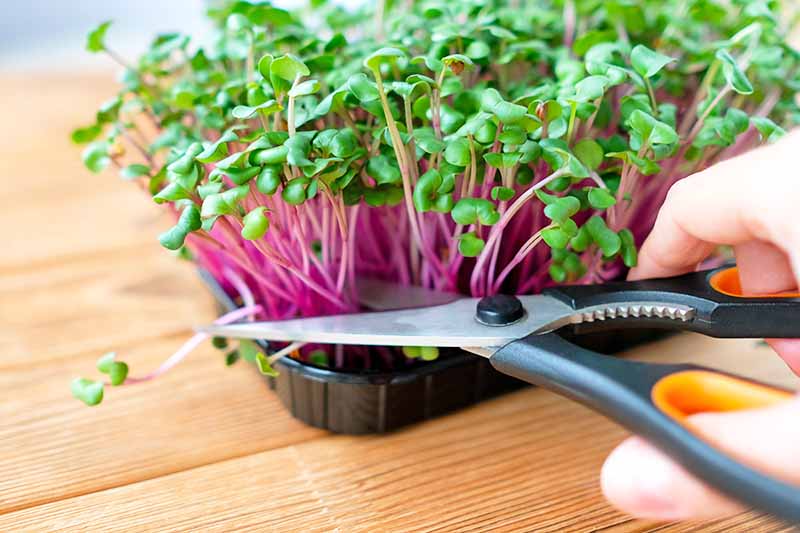
Shun knives also come in a left-handed version.